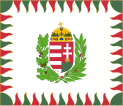
Back የሃንጋሪ ሰንደቅ ዓላማ Amharic Bandera d'Hongría AN علم المجر Arabic علم المجر ARZ Macarıstan bayrağı Azerbaijani Сцяг Венгрыі Byelorussian Сьцяг Вугоршчыны BE-X-OLD Национално знаме на Унгария Bulgarian হাঙ্গেরীর ফিরালহান BPY Zastava Mađarske BS
You can help expand this article with text translated from the corresponding article in Hungarian. (June 2020) Click [show] for important translation instructions.
|
 | |
| Use | Civil and state flag |
|---|---|
| Proportion | 1:2 |
| Adopted | 23 May 1957[1] (as state flag) 19 June 1990[2] (reaffirmed) |
| Design | A horizontal tricolour of red, white and green |
 | |
| Use | Civil flag and ensign |
| Proportion | 2:3 |
| Adopted | 18 August 1957[3] (as civil ensign) |
| Design | A horizontal tricolour of red-white-green |
 | |
| Use | Unofficial state flag[note 1] |
| Proportion | 1:2 |
| Adopted | 10 October 1995[4] |
| Design | A horizontal tricolour of red, white and green with the state coat of arms in the centre. |
 | |
| Use | Unit colour |
| Proportion | 6:7 |
| Adopted | 15 March 1991[5] |
 | |
| Use | Naval ensign |
| Proportion | 3:4 |
| Adopted | 1991[5] |
The national flag of Hungary (Hungarian: Magyarország zászlaja) is a horizontal tricolour of red, white and green. In this exact form, it has been the official flag of Hungary since 23 May 1957. The flag's form originates from national republican movements of the 18th and 19th centuries, while its colours are from the Middle Ages.[6][7] The current Hungarian tricolour flag is the same as the republican movement flag of the United Kingdom (used since 1816) and the colours in that form were already used at least since the coronation of Leopold II in 1790, predating the first use of the Italian Tricolour in 1797.
- ^ "1957. évi II. törvény a Magyar Népköztársaság Alkotmányának módosításáról" [Act II of 1957 on the Amendment of the Constitution of the Hungarian People's Republic]. hu.wikisource.org (in Hungarian). Retrieved 23 February 2017.
- ^ "1990. évi XL. törvény a Magyar Köztársaság Alkotmányának módosításáról" [Act XL of 1990 on the Amendment of the Constitution of the Hungarian Republic]. Törvények és országgyűlési határozatok (in Hungarian). Retrieved 14 March 2018.
- ^ "51/1957. (VIII. 18.) Korm. számú rendelet a magyar tengeri kereskedelmi hajók lobogójáról" [Decree of the Government No. 51/1957. (VIII. 18.) on the Ensign of the Hungarian Maritime Merchant Vessels]. hu.wikisource.org (in Hungarian). Retrieved 23 February 2017.
- ^ "1995. évi LXXXIII. törvény a Magyar Köztársaság nemzeti jelképeinek és a Magyar Köztársaságra utaló elnevezésnek a használatáról" [Act LXXXIII of 1995 on the usage of the national symbols and name of the Hungarian Republic]. Törvények és országgyűlési határozatok (in Hungarian). Retrieved 14 March 2018.
- ^ a b "A Magyar Honvédség új felségjelzése és hadilobogói" [The new insignia and war ensigns of the Hungarian Defence Forces]. Haditechnika. 25 (3): 3–4. 1991.
- ^ Examples of original surviving medieval charters of the Kingdom of Hungary where the seal was attached to the charter using braided cords of red, white and green silk:
- "Charter issued by the Chapter of Eger". National Archives of Hungary. 1323. DL 2205. Retrieved July 19, 2023 – via Hungaricana.
- "Royal charter issued by Matthias Corvinus". National Archives of Hungary. 1477. DL 100877. Retrieved July 19, 2023 – via Hungaricana.
- "Charter issued by Judge royal Stephen VIII Báthory". National Archives of Hungary. 1487. DL 81971. Retrieved July 19, 2023 – via Hungaricana.
- "Royal charter issued by Vladislaus II". National Archives of Hungary. 1501. DL 13582. Retrieved July 19, 2023 – via Hungaricana.
- "Charter issued by Judge royal and Voivode of Transylvania Count Peter Szentgyörgyi". National Archives of Hungary. 1504. DL 70141. Retrieved July 19, 2023 – via Hungaricana.
- "Royal charter issued by Vladislaus II". National Archives of Hungary. 1508. DL 101402. Retrieved July 19, 2023 – via Hungaricana.
- "Charter issued by the Chapter of Pressburg". National Archives of Hungary. 1515. DL 82435. Retrieved July 19, 2023 – via Hungaricana.
- "Royal charter issued by Louis II". National Archives of Hungary. 1519. DL 82532. Retrieved July 19, 2023 – via Hungaricana.
- "Royal charter issued by Louis II". National Archives of Hungary. 1525. DL 24335. Retrieved July 19, 2023 – via Hungaricana.
- "Charter issued by the Chapter of Buda". National Archives of Hungary. 1527. DL 58318. Retrieved July 19, 2023 – via Hungaricana.
- ^ "the Streets, through which the King is to go, being Boarded and covered with White, Green, and Red Cloth" "Of the Ceremonies observed in the Coronations of the Kings and Queens of Hungary", The Present State of Hungary (1687). United Kingdom: (n.p.). at Google Books
Cite error: There are <ref group=note> tags on this page, but the references will not show without a {{reflist|group=note}} template (see the help page).
© MMXXIII Rich X Search. We shall prevail. All rights reserved. Rich X Search